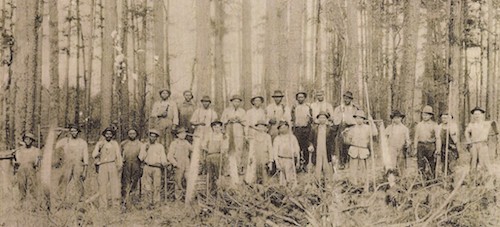
(Image Courtesy of Maxville Heritage Center)
Maxville, in Wallowa County, in northeastern Oregon, was home to African American loggers in the early years of the 20th Century. Maxville had a population of about 400 residents, 40 to 60 of them African American. It was the largest town in Wallowa County between 1923 and 1933.
The Bowman-Hicks Lumber Company, based in Missouri, recruited experienced loggers from throughout the South and Midwest for the Maxville logging operation, and most of them traveled in boxcars to Wallowa County. The company built a new town for the loggers and their families, both white and black, at Bishop’s Meadow. Originally named Mac’s Town, after Bowman-Hicks superintendent R.D. MacMillan, the name was changed to Maxville.
Company jobs were typically segregated based on ethnic origin. Black workers felled the trees in teams, using cross-cut saws, and many had experience as log loaders, log cutters, railroad builders, tong hookers, and section foremen. In Maxville, they mainly worked as log cutters although there are firsthand accounts of black workers repairing and maintaining the log-train engines. The white employees worked as section foremen, tree toppers, saw filers, contract truck drivers, and bridge builders.
The town had a post office, medical dispensary, company store, hotel, horse barn, blacksmith, and roundhouse to turn the log-train engines. Only one structure remains from that boom time, a large log building where the Bowman-Hicks Lumber Company ran the business. The building also served as a meeting place for residents of Maxville.
Maxville was mapped according to an often-used template in company towns, one that segregated residents by marital status and ethnicity. Maxville also segregated the schools, building a white school on one end of town and a black school at the other. Although the loggers worked in integrated teams in the woods, the baseball teams were segregated except during regional tournaments. In the early 1930s, the combined (racially integrated) Maxville team won a tournament in nearby Elgin.
Economic conditions brought on by the Great Depression and the consequent long downturn in the lumber market, caused Maxville’s decline. When the logging operation ceased, Bowman-Hicks closed the town in 1933. Several of the African American families moved to Wallowa while others migrated to nearby La Grande or to Portland. Those remaining in the area by the early 1940s left to work in the Kaiser Shipyards in Portland and Vancouver, Washington.
Those who stayed in northeast Oregon found jobs in janitorial services, on the railroads, and as blacksmiths and mechanics. Other families migrated to California to continue work in the logging industry. A small number of loggers continued to work in Maxville until the mid-1940s, when a severe winter storm destroyed most of the remaining structures.

